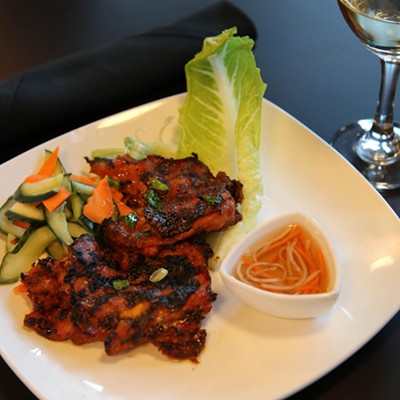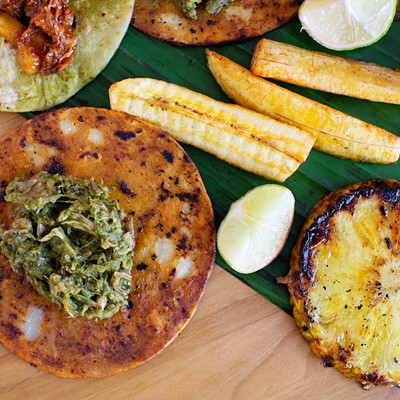I've always remembered the view from that hole, a glimpse of the sultry Ethiopian dusk. Outside, the streets were filled with dust and lepers, the muezzins calling the faithful to pray, and the faithful praying. And through that hole came floating the most intoxicating scent of a hot, spicy African night. Someone was cooking with the most beguiling spices and aromatics. How I longed to fit myself through that hole and float along until I found that bubbling pot.
How lucky we are here in Tucson: Zemam's offers up its own version of that bubbling pot. Although there are no fairy deer, the cozy little tart of a restaurant sits back off Broadway in what appears to be someone's former Tucson-style bungalow.
Tucson has its fair share of restaurants housed in old homes, although they are rapidly dwindling, and it is good news indeed that Zemam's has kept the door open for six years.
The small series of dining rooms is immaculate, whitewashed and simple. There is something soothing about the simplicity of Zemam's, as if you are about to be restored to something elemental, something that has nothing to do with the six lanes of packed traffic outside the door.
Make sure your hands are clean. In true Ethiopian fashion, you will be served your food without utensils. As long as your hands are sanitary, there is no need to get squeamish. In many countries all over the world, eating with one's hands is a sign of trust and good manners. Of course, there are many complicated rules that go along with this depending on where you eat: In some countries you must eat only with your right, never with your left; in others you are a murderer or a thief depending on the hand that you use.
Given that nearly every country on the face of the earth now sports a McDonald's or Pizza Hut, we can probably dispense with the deeper need to unearth and preserve nuance. (Which hand is the correct hand? Will anyone care if I lower my head and just shovel it in?) We should just be grateful that we are given the opportunity to partake of food in its most elemental form: on flat bread with our hands.
Probably the best way to eat at Zemam's is to try everything. If you order the Zemam's Plate ($7.75) you get a sampler of three different menu items of your choice. If you go with a party of at least three you'll get to taste the entire menu, as there are only nine possible entrées. This is the recommended plan of attack.
All entrées will be served on a tray of native flat bread. A spongy, slightly sour bread, this injera is an Ethiopian mainstay, and it is served as both your plate and your spoon. Any dish that you order at Zemam's will be ladled onto a tray covered with injera. In Ethiopia, we ripped the injera right up off the tray and used that as a utensil to eat the sauces. Simple. Economic. Efficient. However, at Zemam's you'll get an entire basket of the flat bread along with your tray, so there is plenty to go around.
As all nine of the dishes are heavily seasoned and spiced, the injera becomes a necessity. As there are many fasting days in Ethiopia (some religious, some involuntary), Ethiopian cuisine offers an extraordinary range of vegetarian dishes. Over half of the offerings at Zemam's are vegetarian, and take the form of rich and satisfying stews. What sets Ethiopian cuisine apart as singular is the celebration of aromatics and spices used to make the holy vegetable holier: chiles, cardamom, onion, holy basil, mint, fenugreek, ginger. Zemam's is no exception. Though fear not, stalwart carnivore; several meat are also offerings available.
My favorite is the Yebeg Wat ($8), a zippy and satisfying lamb stew spiked with chile. The lamb is cooked until just tender. There is a slightly sweet note to the dish, the bite of chile, and the rich savory broth. This goes quite well with the Spinach Wat ($6.25), a rich and generous helping of simmered spinach, onion and yogurt, served with a small dollop of cottage cheese. The simplicity of this dish also serves as an excellent foil for nearly all the other fiery or highly seasoned offerings.
The Shiro ($5.75), puréed chickpeas and berbere, should not be missed. Berbere, a traditional Ethiopian chile paste made up of cardamom, fenugreek, peppercorn, coriander, chile, cinnamon, ginger and basil, is a scintillating experience. The fat little chickpeas offer up a creamy and savory texture to showcase the spices.
The Zigni ($7.25), tender beef strips simmered in a red chile sauce, and Lega Tibs ($7.25), cubes of beef cooked in just a mildly seasoned tomato sauce, serve as excellent reminders that even though thousands of miles separate us, people who live in very hot places enjoy very similar foods. Instead of tortilla, Ethipians use injera; instead of a northern New Mexico red chile or enchilada sauce, they have Zigna. These are mere technicalities, since these dishes offer up the same familiar range of flavors and comforts. These are spicy dishes for fiery landscapes: what we need to eat to sustain us from the harsh environment in which (some of us) live.
Although the Kik Wat ($7.25; split peas simmered with onion, garlic and bits of green bell peppers) and the Yetakelt Wat ($6.50; fresh steamed vegetables and potatoes) are solid vegetarian offerings, they tasted surprisingly similar in both seasoning and texture.
The Doro Wat ($7.25), a traditional chicken dish simmered in berbere and served with hard-boiled eggs, is delicious even if the presentation is a bit odd. A proud drumstick arrives tableside afloat in a pool of berbere sauce. On the night we were served, there were no hard-boiled eggs. As we were all sharing, we warily watched the drumstick circle the table. Finally, the more cannibalistic in the crew picked it up and gnawed away happily. There really was no way to share this item, and we were all a bit jealous we hadn't been the first to seize the moment, or the leg, as the case may be. But our dining companion confided that it was delicious.
What might be another man's sole means of survival can easily be translated into another man's pleasure. At Zemam's, the food is honest, rich and filling. We couldn't finish our Zemam's platter and there was considerable guilt at the table about this, given the status of most people living in Ethiopia. But we assuaged our guilt by promising to visit again and make sure that Zemam's has as much business as it can possibly handle.
We recommend that you do the same.
Zemam's. 2731 E. Broadway Blvd. 323-9928. Open 11:30 a.m. to 2:30 p.m. and 5:30 to 9 p.m. Tuesday through Sunday. B.Y.O.B. V, MC, checks. Menu items: $5.75-$8.00.








